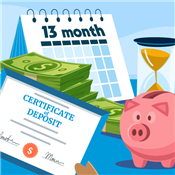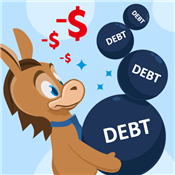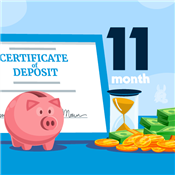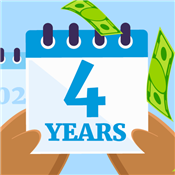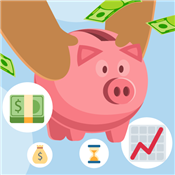How to Make a Budget
A budget will help you track your finances and reach your goals sooner. Here is a step-by-step on how to make a budget that works.
 |
Is money tight every month?
Do you have savings goals that you just can't seem to reach?
Would an emergency completely wipe you out?
You're not alone. 2 out of 5 Americans have less than $500 in savings.
- Verify your income
- Track your expenses
- Set savings goals
- Separate NEEDS from WANTS
- Make some cuts to reach your goals
Living paycheck to paycheck can be risky business. An unexpected expense like car repairs or a root canal can leave you stress-eating mac and cheese for the rest of the month.
And forget about goals like saving for a house or a vacation to your dream destination.
Take control of your financial future by making a budget. Don't worry, it only takes a few minutes to get started
Read on for 5 simple steps to make a budget that you can stick to.
WHAT IS A BUDGET?
Simply put, a budget is a written list of your income (what you make) and expenses (what you spend). Making one will show you WHERE your money goes every month.
 |
Remember: it doesn't need to be a complicated time-suck. All you'll need is a pencil and paper to get started.
You can also create your budget on a laptop or smartphone using:
- Spreadsheets: Start a simple budget of income and expenses using Excel or a similar program. You can develop a more detailed one with itemized categories later if you like.
- Apps: Online and mobile budgeting tools like Mint, Empower, YNAB can do the work for you. But you'll need to link your bank accounts and credit cards so the app can extract the information.
Now that you know where you'll be tracking your budget, keep reading to learn how to get started.
1. CALCULATE YOUR TAKE-HOME PAY
To make your budget, start by calculating your net income every month. Net income - often called take-home pay - is the money you receive AFTER the deductions from your paycheck (including taxes and 401(k) contributions).
For most people, all you have to do is look at your paycheck (or the direct deposit into your bank account) to see what you're earning.
But remember you want your MONTHLY income. So, for example, if you get paid twice a month, add the total from both checks.
But mistakes DO happen. Make a point of looking at your statement every payday. You should be able to access it by email or through your company's online or mobile HR portal. Report any problems or discrepancies immediately.
If you're a freelancer or have your own small business, figuring out what you make can be a little harder. Look back at your earnings over the past year and calculate an average. Then deduct
- Taxes
- Retirement contributions
- Healthcare costs
Whatever amount is left over is your monthy income.
2. DETERMINE YOUR EXPENSES
Now it's time to figure out how much you spend every month. You'll want to record:
- Fixed expenses: These include rent, utilities, insurance, student loan, and car payments and other set monthly charges.
Tip: Don't forget about credit card debt. Everyone makes financial mistakes so there's no use beating yourself up over old debt. But you do want to get from under it as soon as possible.
If you're carrying around credit card or other high interest debt, decide on a fixed amount you can afford to pay above the monthly minimum. Add that to the Fixed Expenses section of your budget.
- Necessary, not fixed expenses: These are costs that may vary from month to month like gas and groceries.
- Discretionary spending: These "fun expenses" includes costs like eating out, clothing shopping, and entertainment. You can separate these into categories if you like.
The last category will probably be the hardest. Most people spend a lot more than they think—small daily purchases like snacks and coffees can really add up.
You could write down every single thing you spend for a month. But let's be honest—no one has that kind of time. Instead, try using a credit card to track your spending habits.
The truth is, paying with cash or a debit card makes it difficult to see just how much you're spending. But charging your everyday purchases will allow you to look back at your statement.
Just make sure to pay off the whole balance on your card to avoid unwanted interest charges.
Carla Dearing, CEO of Sum180, a mobile financial wellness service
3. SET YOUR GOALS
Now it's time to consider your savings goals. This will help you stick to your budget by giving you something to aim towards.
We recommend starting a rainy day or emergency fund BEFORE moving onto your short and long term goals. This way, you have backup if something bad happens (like losing your job).
Make a list of short-term and long-term goals.
- A short-term goal is one that can be reached in a year or less - maybe a new laptop or well-earned tropical vacation.
Put your savings into a high-yield savings account. It doesn't take a large amount to see the virtue of compound interest - interest paid on interest. This will help you grow your savings little by little.
- Long-term goals are usually BIG expenses like buying a house, retirement or sending your children to college. These will take years to achieve but keeping your short-term expenses in line will help.
4. CREATE YOUR BUDGET
Now comes the moment of truth—it's time to make your budget.
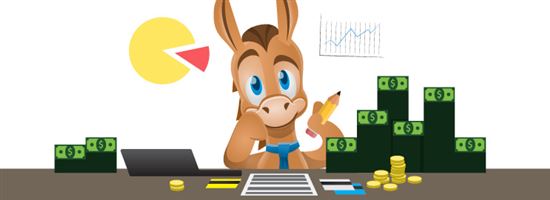 |
Here's a sample to show you how it works.
Let's say your take-home income is $3,500 a month. And your monthly expenses look like this:
- Rent: $1,000
- Car payment and insurance: $400
- Student loan payment: $200
- Credit card payment: $200
- Utilities/gas: $300
- Groceries: $200
- Fun spending: $800
- Total: $3,100
That leaves you with $400 extra for the month. Not too shabby but we still haven't considered your monthly savings goals:
- Emergency fund: $100
- Dream vacation fund (short term goal): $100
- House down payment savings (long term goal): $500
- Total: $700
Based on this breakdown, you'd be $300 over budget, which means you won't reach your monthly goals. In other words, something's got to give.
If this is how your budget looks, don't worry. We'll show you how to fix it below.
One budget area people typically forget is that things, in general, wear out and break. Everything from electronics to vehicles to shoes eventually need to be replaced. So making sure you have money set aside will keep you from busting your budget when your phone suddenly stops working, for example.
Amanda Abella, owner and creator of AmandaAbella.com
5. REVIEW YOUR EXPENSES
If you're one of those lucky few, you've made your budget (including your savings goals) and come out with money to spare. Good for you! But that's not the case for most of us.
If you're over-budget, it's time to start making some cuts. DON'T start with your savings goals. Those may need to be adjusted but it's best to find places where your spending can be trimmed first.
- 50% on Needs like housing, food, insurances and other necessities
- 30% on Wants like shopping and entertainment
- 20% on Savings
For a monthly income of $3000, this breaks down like so: $1500 on Needs, $1000 on Wants, and $500 on Savings.
Taking the example above, we could start with the "Fun Spending" like shopping, eating out, and entertainment. $800 gives you $200 a week—that's a lot of cash. Perhaps you could cut back there to save more.
That might mean spending $50 less each weekend. Or choosing to stay in, cook, and watch Netflix one weekend a month.
In other words, meeting your goals means separating between Needs and Wants. This process will be different for everyone because we all prioritize specific things.
If you drive to work each day, gasoline and scheduled maintenance are a need. But take-out for lunch, a few drinks at the bar, or another pair of fancy shoes are wants.
In fact, you're just setting yourself up to fail if your budget is too strict. A manageable one is better than none, even if your savings goals take a little longer.
Once you've found some areas to trim, re-adjust your budget accordingly. If all else fails, you may have to cut back on your goals. Perhaps you can cut your monthly short- and long-term savings expectation in half.
But we recommend you avoid trimming your emergency fund savings. Remember: that financial cushion will save you if disaster strikes.
Carla Dearing
Bonus Tips
 |
| © CreditDonkey |
We get it—not everyone has the time (or desire) to sit down and review their income and spending every month. But even making a budget once can show you where things stand.
After that, it's a matter of making conscious choices, whether you ever look at your budget again or not. The goal is to save money but how you get there is up to you.
Here are some tricks that may help:
- Play the Numbers Game: Let's say you've budgeted $200 a month or $50 a week (most months) for groceries. That's a pretty easy number to remember. You can even make a fun little game of it during your weekly shopping trip to stay within your goal.
There's a lot you can do to stretch your grocery budget. Check out these five tips from Wallet Wise Guy to help both that money last longer and your dinners taste better.
- Add, Rather Than Subtract, Fun: This one is all a matter of perspective. Rather than thinking in terms of cutting out things you love, plan to include them. You aren't skipping Taco Tuesday with friends; you're
yourself one Taco Tuesday a month. Sounds silly but it works. - Enjoy Your Built-In Excuse: Really don't feel like going out on Friday night? Tell your friends you're trying to save money. They'll understand, and you get rewarded with a gloriously lazy night of not having to wear pants.
- Create Specialized Savings Accounts: It's tough to track progress when all your money is lumped together. Many online banks allow you to open multiple accounts.
Start one for each goal: Rainy Day Fund, Short Term Goal and Long-Term Goal.
Transfer money from your checking account every month, even if it's just a few dollars.
Related: Chase Checking Account Bonus- Create Hacks for Your Habits: Everyone is tired of lame "Don't Buy Coffee Every Morning" advice. But there's truth buried within that cliché.
If you are a caffeine addict, spring for a nice coffeemaker and a travel mug. The one-time expense will pay off in no time. The same holds true for whatever your expensive "pet habit" may be:
- Going out for lunch? There's nothing more depressing than a brown bag lunch. But with a couple hours of weekend food prep, you can make great lunches for a fraction of the cost of ordering out at your desk.
- Video games? Consider renting from places like Redbox instead of buying.
- TV? Save on huge cable bills by cutting the cord and streaming content instead.
- Music? You've got all sorts of choices of options, from Spotify to Apple Music.
- Books? Consider getting a library card or signing up for a service like Kindle Unlimited or Audible.com.
- Clubbing? Dancing is free--it's the booze that'll cost you. Have a drink or two at home then Uber (NOT drive) to your destination.
No matter what you enjoy, there's a creative way to plan for it and still save money.
- Wait a Day Before Making Purchases: Anyone who's walked into a department store for toothpaste and walked out with a cart full of purchases knows the dangers of shopping.
If you're about to make an unexpected purchase, consider holding off a day or two to see if the urge passes. You'd be surprised how often the "I need this" fades when you're back home on the couch.
BOTTOM LINE
A smart, reasonable budget can help you cut down on costs AND save for the future. All it takes is a few minutes to record your income and expenses.
You'll need discipline to stick to it—and more than a little patience. Don't give up after one bad month. Remember: the goal is to save money over time. There will be ups and down along the way.
And here's the good news: your income should increase as your career advances. Hopefully those gains will outpace the increases in your expenses. Review and update your budget ever month to gauge your progress.
Write to Scott R at feedback@creditdonkey.com. Follow us on Twitter and Facebook for our latest posts.
Note: This website is made possible through financial relationships with some of the products and services mentioned on this site. We may receive compensation if you shop through links in our content. You do not have to use our links, but you help support CreditDonkey if you do.
Empower Personal Wealth, LLC (“EPW”) compensates CREDITDONKEY INC for new leads. CREDITDONKEY INC is not an investment client of Personal Capital Advisors Corporation or Empower Advisory Group, LLC.
Read Next:

